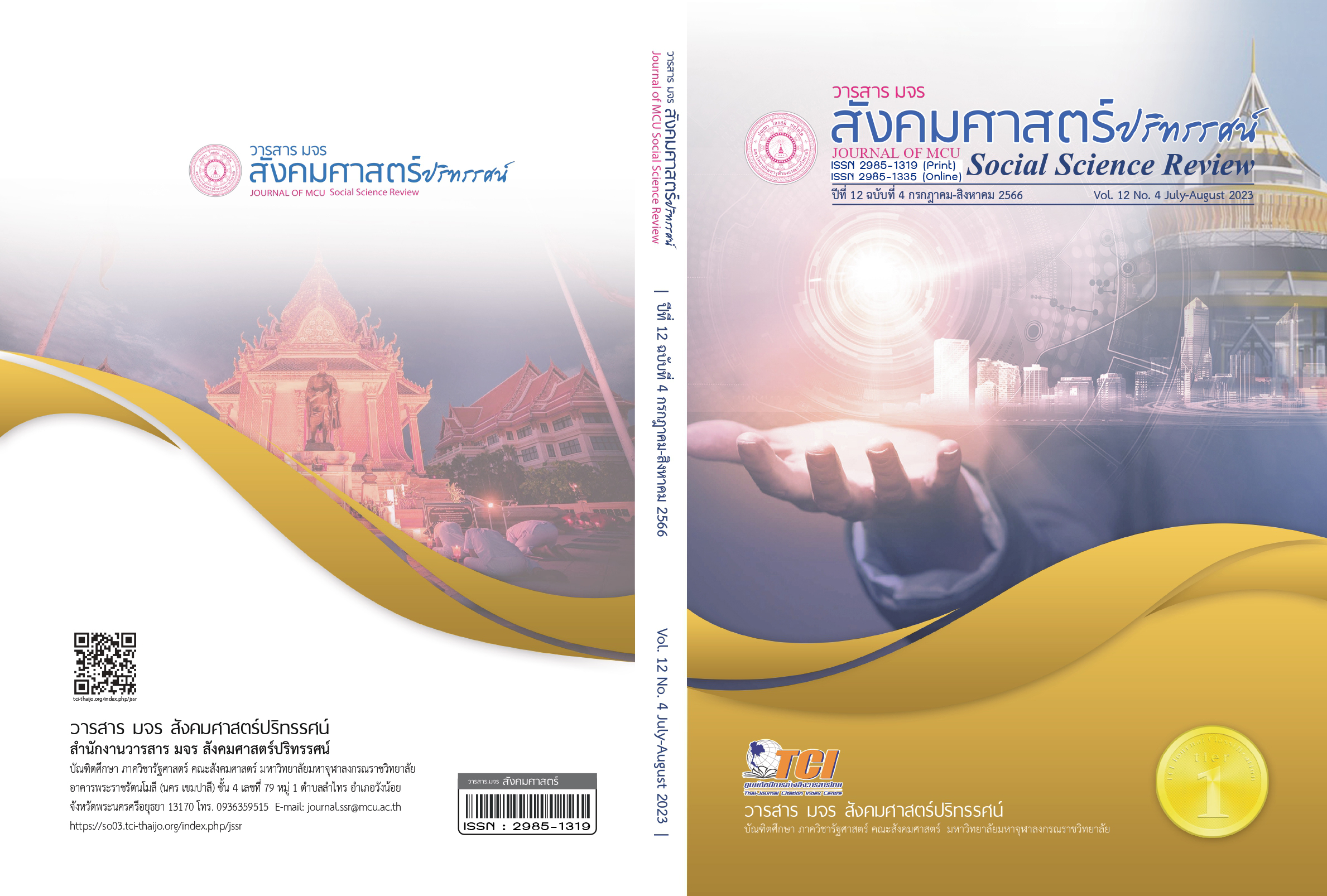พุทธบูรณาการเพื่อเสริมสร้างประสิทธิภาพการปฏิบัติงานของบุคลากร สำนักงานส่งเสริมการศึกษานอกระบบและการศึกษาตามอัธยาศัย ในการส่งเสริมสุขภาวะของผู้สูงอายุ
คำสำคัญ:
พุทธบูรณาการ, ประสิทธิภาพ, สุขภาวะผู้สูงอายุบทคัดย่อ
บทความวิจัยนี้มีวัตถุประสงค์เพื่อ 1. สภาพทั่วไปเกี่ยวกับประสิทธิภาพการปฏิบัติงาน 2. ปัจจัยที่ส่งผลต่อประสิทธิภาพการปฏิบัติงาน และ 3. นำเสนอรูปแบบพุทธบูรณาการเพื่อเสริมสร้างประสิทธิภาพการปฏิบัติงานของบุคลากรสำนักงานส่งเสริมการศึกษานอกระบบและการศึกษาตามอัธยาศัยในการส่งเสริมสุขภาวะของผู้สูงอายุ เป็นแบบผสานวิธี การวิจัยเชิงปริมาณเก็บข้อมูลใช้แบบสอบถาม จากกลุ่มตัวอย่าง 233 คน โดยใช้สูตรการคำนวนของ Taro Yamane กำหนดความเชื่อมั่นที่ 0.05 วิเคราะห์ข้อมูลโดยใช้สถิติ คือ ค่าเฉลี่ย ค่าเบี่ยงเบนมาตรฐาน และการถดถอยพหุคูณ การวิจัยเชิงคุณภาพ เก็บข้อมูลด้วยแบบสัมภาษณ์ จากผู้ให้ข้อมูลสำคัญ จำนวน 20 รูปหรือคน เลือกแบบเจาะจง จากผู้เชี่ยวชาญที่เกี่ยวข้องมีประสบการณ์เกี่ยวกับผู้สูงอายุ และจากผู้ร่วมในการสนทนากลุ่มเฉพาะจำนวน 10 รูปหรือคน เลือกแบบเจาะจง วิเคราะห์ข้อมูลโดยการวิเคราะห์เนื้อหาเชิงพรรณนา
ผลการวิจัยพบว่า 1. สภาพทั่วไปของประสิทธิภาพการปฏิบัติงานของบุคลากรโดยภาพรวมและรายด้านประกอบด้วยประสิทธิภาพด้านความรู้ ความสามารถ ด้านการบริหารจัดการที่ดี ด้านทักษะวิชาชีพ และด้านการนำพุทธบูรณาการมาใช้ อยู่ในระดับมากทุกด้าน 2. ปัจจัยที่ส่งผลต่อประสิทธิภาพในการปฏิบัติงาน พบว่า ปัจจัยเสริมสร้างการปฏิบัติงานส่งผลต่อประสิทธิภาพการปฏิบัติงานร้อยละ 81.50 และการปฏิบัติตามหลักอิทธิบาท 4 ส่งผลต่อประสิทธิภาพในการปฏิบัติงานร้อยละ 95.10 และ 3. รูปแบบพุทธบูรณาการเพื่อเสริมสร้างประสิทธิภาพการปฏิบัติงาน พบว่า ประสิทธิภาพการปฏิบัติงานของบุคลากรเกิดจากปัจจัยเสริมสร้างการปฏิบัติงาน โดยบูรณาการหลักอิทธิบาทธรรม ได้แก่ 1) ฉันทะ (มีใจรัก) 2) วิริยะ (พากเพียรทำ) 3) จิตตะ (ติดตาม ตรวจสอบ) 4) วิมังสา (รอบคอบ แก้ไข ประยุกต์ใช้)
เอกสารอ้างอิง
กรมสุขภาพจิต. (2564). คู่มือความสุข 5 มิติสำหรับผู้สูงอายุ. นนทบุรี: โรงพิมพ์ชุมนุมสหกรณ์การเกษตรแห่งประเทศไทย จำกัด.
ธงชัย คล้ายแสง. (2562). การพัฒนาการท่องเที่ยวเชิงกีฬาโดยการบูรณาการหลักพุทธธรรมของจังหวัดบุรีรัมย์ (ดุษฎีนิพนธ์ปรัชญาดุษฎีบัณฑิต สาขาวิชารัฐประศาสนศาสตร์). พระนครศรีอยุธยา: มหาวิทยาลัยมหาจุฬาลงกรณราชวิทยาลัย.
พระมหาปรีชา เขมนนฺโท (เหล่าทวีคุณ). (2561). การประยุกต์หลักอิทธิบาทธรรมเพื่อการบริหารจัดการสำนักปฏิบัติธรรมในจังหวัดพระนครศรีอยุธยา (ดุษฎีนิพนธ์พุทธศาสตรดุษฎีบัณฑิต สาขาวิชาการจัดการเชิงพุทธ). พระนครศรีอยุธยา: มหาวิทยาลัยมหาจุฬาลงกรณราชวิทยาลัย.
พระมหาวิเศษ กนฺตธมฺโม (มั่งคั่ง). (2564). พุทธบูรณาการเพื่อการพัฒนาประสิทธิผลการบริหารงาน ของเทศบาลเมืองในจังหวัดชลบุรี (ดุษฎีนิพนธ์ปรัชญาดุษฎีบัณฑิต สาขาวิชารัฐประศาสนศาสตร์). พระนครศรีอยุธยา: มหาจุฬาลงกรณราชวิทยาลัย.
สำนักงานส่งเสริมการศึกษานอกระบบและการศึกษาตามอัธยาศัย. (2564). วิสัยทัศน์/พันธกิจ. สืบค้น 25 กรกฎาคม 2564, จาก http://www.nfe.go.th/onie 2019
สำนักงานสภาพัฒนาการเศรษฐกิจและสังคมแห่งชาติ. (2564). กรอบแผนการพัฒนาเศรษฐกิจและสังคมแห่งชาติ ฉบับที่ 13 พลิกโฉมประเทศไทยสู่ เศรษฐกิจสร้างคุณค่า สังคมเดินหน้าอย่างยั่งยืน. สืบค้น 31 กรกฎาคม 2564, จาก https://www.nesdc.go.th
Fiske, A., et al. (2009). Depression in Older Adults. Annual Review Clinical Psychology, 5(1), 363-370.
ดาวน์โหลด
เผยแพร่แล้ว
รูปแบบการอ้างอิง
ฉบับ
ประเภทบทความ
สัญญาอนุญาต
ลิขสิทธิ์ (c) 2023 วารสาร มจร สังคมศาสตร์ปริทรรศน์

อนุญาตภายใต้เงื่อนไข Creative Commons Attribution-NonCommercial-NoDerivatives 4.0 International License.
เพื่อให้เป็นไปตามกฎหมายลิขสิทธิ์ ผู้นิพนธ์ทุกท่านต้องลงลายมือชื่อในแบบฟอร์มใบมอบลิขสิทธิ์บทความให้แก่วารสารฯ พร้อมกับบทความต้นฉบับที่ได้แก้ไขครั้งสุดท้าย นอกจากนี้ ผู้นิพนธ์ทุกท่านต้องยืนยันว่าบทความต้นฉบับที่ส่งมาตีพิมพ์นั้น ได้ส่งมาตีพิมพ์เฉพาะในวารสาร มจร สังคมศาสตร์ปริทรรศน์ เพียงแห่งเดียวเท่านั้น หากมีการใช้ภาพหรือตารางหรือเนื้อหาอื่นๆ ของผู้นิพนธ์อื่นที่ปรากฏในสิ่งตีพิมพ์อื่นมาแล้ว ผู้นิพนธ์ต้องขออนุญาตเจ้าของลิขสิทธิ์ก่อน พร้อมทั้งแสดงหนังสือที่ได้รับการยินยอมต่อบรรณาธิการ ก่อนที่บทความจะได้รับการตีพิมพ์ หากไม่เป็นไปตามข้อกำหนดเบื้องต้น ทางวารสารจะถอดบทความของท่านออกโดยไม่มีข้อยกเว้นใดๆ ทั้งสิ้น





